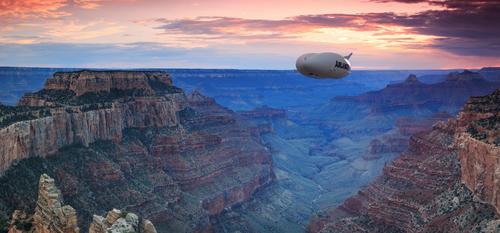September 16, 2016

Momentum is growing behind a technology that promises to combine the qualities of lighter-than-air airships with traditional fixed-wing aircraft.
The Airlander 10, as it's known, is bigger than the famed Goodyear Blimp, cruises at almost 90 mph, and can carry a payload of more than 11 tons. "Lots of people have dreamed of mixing an airship with a fixed-wing aircraft," Chris Daniels, head of communications for Hybrid Air Vehicles, which makes the Airlander 10, told Design News. "They dreamed of it because lighter-than-air flight is very efficient. But heavier-than-air flight is more controllable, faster, and better in harsh weather conditions."
The helium-filled Airlander 10 has reportedly been able to combine those qualities because it is heavier than air and employs a more aerodynamic shape than conventional blimps. "To get all those characteristics, you need materials that are strong and light enough, so you can create a new shape," Daniels told us.
Click on the image below to learn more about the Airlander 10
To accomplish that, Hybrid Air Vehicles engineers employed a combination of materials used in America's Cup yacht racing. The aircraft's 1 mm-thick skin includes a yarn-like interior layer called Vectran, a middle layer of Mylar polyester film, and a polyvinyl fluoride film known as Tedlar. Five tons of the woven material cover a structure that measures 302 feet long, 143 feet wide, and 85 feet high. By comparison, the Goodyear Blimp is 192 feet long and 50 feet wide.
Hybrid Air Vehicles' engineers say the structure couldn't have been built a few decades ago. First, they say, the woven blend of materials would have been unavailable, making it impossible to create the vehicle's shape. Second, engineers didn't have access to computational fluid dynamics techniques, which make it possible to design the Airlander 10 without having to build numerous scale models and test them in wind tunnels.
"We got the early models more or less right, then merely refined them in the wind tunnels and refined them again in scale models," Daniels said.
READ MORE ABOUT AEROSPACE VEHICLES:
The resulting aircraft, powered by four 325-HP turbocharged diesel engines, contains two big fins, each about the "size of a tennis court," which serve as control surfaces. Pneumatic tubes, or "skids," enable it to land on the ground like a pontoon-equipped water aircraft. It currently requires a ground crew of four people to help with landings, but the company ultimately envisions it landing with no ground crew members at all. In comparison, a conventional blimp requires a ground crew of about 15 to 20 to moor it.
Airlander made its first flight on Aug. 17, 2016. BBC News subsequently reported that the vehicle was damaged after nosediving on its second flight on Aug. 24.
Hybrid Air Vehicles has been awarded UK and European grant funding to support development of the aircraft. The company has also carried out two "crowdfunding" rounds and now has about 2,000 shareholders.
The company foresees it being used in a wide variety of applications that don't compete with traditional air carrier business. Those include movement of cargo to remote locations, including mining and construction sites. They also see it being used in ultra-endurance applications and in sightseeing tours at popular locations, such as the Grand Canyon.
"We have a great passenger experience," Daniels told us. "It's nearly silent and totally stable. You can open a window, get fresh air, and watch the best places in the world go by at a lovely, leisurely pace."
Senior technical editor Chuck Murray has been writing about technology for 32 years. He joined Design News in 1987, and has covered electronics, automation, fluid power, and autos.
About the Author(s)
You May Also Like



